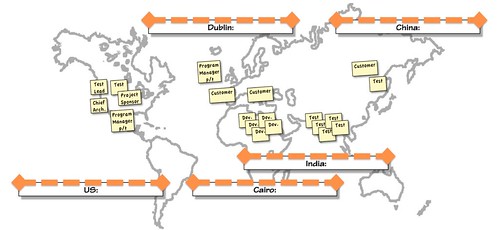"Bringing this project up to the starting line is a story in itself however I can say we had a great start. A really compelling prototype, demonstrated all the key functionality; web access, cloud data, simple workflow, fine grained ownership with security, reporting, detailed versioning, multilingual. We demonstrated the capacity to delivery a key internal service to the global company. You don't really need to know too much about the detail."
"The initial prototype was a joint production between Santa Monica (US) and Dublin, we pitched the project at our quarterly Knowledge Exchange event. In the company we call this kind of bidding process 'outsourcing inside'. We ended up with bids from three other groups, from our offices in Cairo (Egypt), Pune (India) and Langfang (China). Some of them signed up as 50% 'own time', the others were full-time. Cairo provided full-time developers, Langfang and Pune gave us full-time testers (figure 1)."

Figure 1. Global-Local initial project team
"We applied formal project planning from the start. The project is outsourced to multiple sites so a number of different cultures are involved. From our video calls I can say that the physical environments at all sites appear to be open plan cubicle formats, or 'tube-farms'. It is a tribute to the whole team that a passion for quality and for doing the job well has remained throughout and that is common across all geographies."
"The working cultures have little differences from office to office but I can say that's a strength. The vendor development team in Cairo appear to think little of working 24 hours a day, 7 days a week if they feel it necessary. Some of the flexibility shown in Cairo has its cost. After a 'spike' of effort they need to recover before reverting to normal working hours, inevitably your life outside (or lack of sleep) catches up with you. Those of us in Dublin and the US, we need our sleep and breaks just a little more but we're nearly always on hand to check mail, and, if necessary, work at weekends too. The test teams in India and China are very structured, very productive, and seem to always work the same hours, sometimes little later on busy weekdays, very rarely at weekends. In contrast, the part-time nature of the involvement of some of the players contributes to a certain lack of accountability, after all this isn't their 100% day job. You might load a work-task in Project at 50% but they aren't really able to allocate 50% all the time."
"With the number of locations involved in conference calls we've found that verbal communications can be a big problem. The mixture of accents in each office is compounded by differing audio quality across the sites. Audio and video quality degradation is just unavoidable. We're a global technology leader and only use best-in-class systems and still it's difficult to have perfectly clear group discussions. I think it has been a factor in generating some miscommunication."
"But the situation we're dealing with now... The formal project management approach requires an initial design process, very structured, heavy on documentation and long-winded. Crucially we agreed on multiple customers with different requirements, so every possible feature requirement was included in the plan from the start. You could say, with three customers the project might lack a certain direction. The customers (and I suspect architects) were essentially free to add their own personal dreams into the requirements and specifications. The requirements are also 'moving targets' because the goals of the different customer groups have shifted over time."
"We followed formal project planning practice, a one year schedule with three major milestones: alpha, beta, general release. Each feature had a feature spec written, subjected to a review and sign-off meeting. Feature spec review and sign-off ends up being quite lengthy and it has to happen for each feature. After the feature specification is nailed down the developers create a detailed design spec. This hammers out the finer details of the features. The test teams use the design spec to write a test spec and start generating 'white box' tests. The developers take the design specs and implement them. "
"It was pretty obvious that the formal approach takes time, but it can also lead to over engineered feature specifications. This causes problems elsewhere because of integration, features have to work with each other, and the interdependencies are complicated in unexpected ways. The alpha milestone was the point where first draft features were integrated. Debugging these interactions and interdependencies takes more time and generates further instabilities."
"It quickly became clear that while the features had been highly designed, perhaps even 'over engineered', their integration with each other was troublesome. While it had been considered during design it was obvious that each feature's designer should have studied the interfaces with the others far more closely. Another factor was that the customers had, in some cases, quite different requirements; the outputs of features customised for one customer regularly caused problems as inputs for features customised for another. Debugging the interactions between the features has pushed the schedule out by months."
"We've been on a 'death march' to reach the beta milestone. Management are beginning to question the project's funding. We have a management meeting next week, the project is close to being canned, but a lot of blood, sweat and tears has been invested. I think everyone wants to give it a chance."
"Starting with a concept, prototyping, and making the funding pitch is the base of a good technology recipe. How to succeed with distributed development teams? That's the secret sauce."